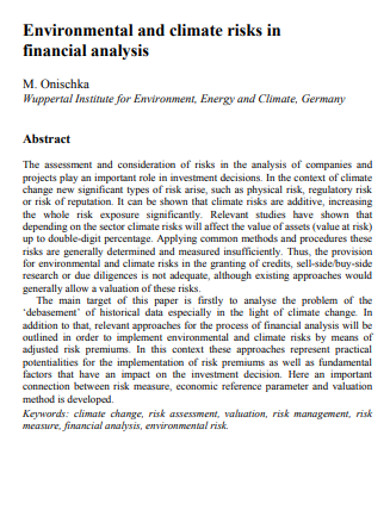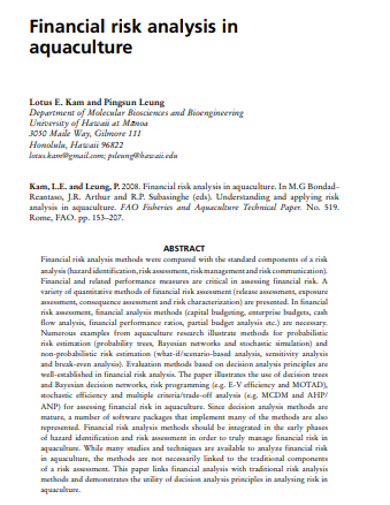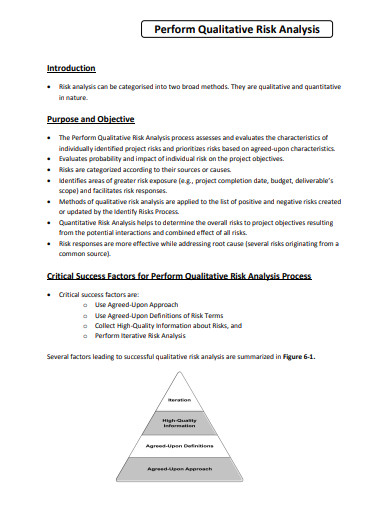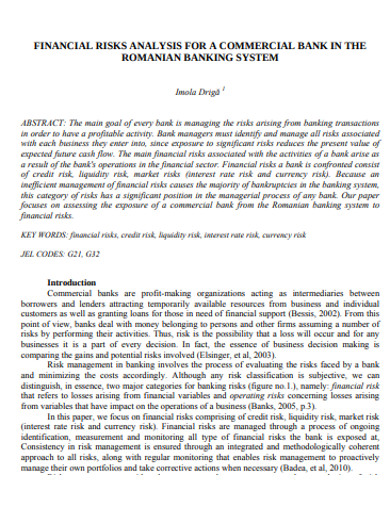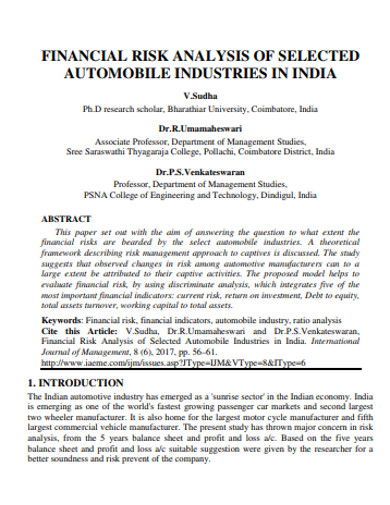5+ Financial Risk Analysis Examples to Download
Financial risk is a term that can be applied to an individual, government entities, businesses, and the financial market. It is commonly referred to as the possibility that a company’s cash flow will prove insufficient to meet its obligations. There are various specific risks that can be categorised as a financial risk; however, some of the most common and distinct include asset-backed risk, equity risk, foreign investment risk, currency risk, liquidity risk, credit risk, and operational risk. Investors can use the aforementioned risks to asses a company’s prospects.
Running a business is harder than what you’re thinking. You need to know about capital, how to allocate it, and make use of it. As a business person, you have to learn about personal finance essentials, corporate finance essentials, financial risk analysis, etc., so you will be guided.
5+ Financial Risk Analysis Examples
1. General Financial Risk Analysis Example
2. Financial Risk Analysis
Financial risk analysis is the process of assessing the likelihood of an adverse event such as cash flow insufficiency occurring within the corporate or in a government sector. Risk analysts often work with financial analysts and forecasting professionals to minimise future negative unforeseen effects. Risk analysis can either be qualitative or quantitative.
3. Qualitative Risk Analysis
Qualitative risk analysis is an analytical method that doesn’t identify and evaluate the risks according to numerical and quantitative ratings. Meanwhile, in quantitative risk analysis, risk analyst builds a risk model using simulation or deterministic statistics to allocate numerical values to risk. Assumed inputs and random variables are fed into a risk model.
4. Commercial Bank Financial Risk Analysis
5. Financial Risk Analysis and Management
6. Sample Financial Risk Analysis Example
How to Perform Financial Risk Analysis
Ignoring the risks in your business may lead to catastrophic losses, theft, failure to thrive, lack of transparency, or lawsuits. It is vital to analyze ad manage the internal and external risks in your corporation to prevent the previously mentioned causes from happening. The following are the steps that you can use to do financial risk analysis:
Step 1: Identify Risks
Identifying the situations that pose a risk to your finances should be the first step to manage the risks in your business. Consider the damages that the risks could have on your business. After doing so, you have to think about your goals and the expected rewards of taking risks. Take note that risks will vary depending on the business, industry, and location.
Step 2: Record the Risks
After identifying the potential risks, you have to have a record of them. You are going to define each risk in a document and develop a process to assess its effect. Focus on how much damage the risks could potentially cause and how difficult it would be to recover. You can set up a scoring system for risks, ranging from mild to severe.
Step 3: Appoint Monitors
You have to identify and assign individuals who will supervise and manage the risks of your business—it could either be you, a business partner, or a capable employee. Moreover, you have to decide how the monitors should report and handle the risks. Issues and controversies can be taken care of smoothly for as long as you have procedures for risk management.
Step 4: Determine Controls
After identifying and understanding potential risks, it’s high time for you to figure out controls that you can utilise to reduce them. Review the historical data of your company and look at patterns over time to predict your business’ income cycle. Moreover, you have to assess the impact of a risk on your business, its significance, and its likelihood of occurring at your business.
Step 5: Review Frequently
Your financial risk analysis or your business is not a one-time commitment; rather, it is continuous. You have to review as frequent as possible the risk management of your business and see how you handle risks. Moreover, look out for any forthcoming risks that might have been irrelevant in the previous assessment.
How to Identify Potential Risks
As mentioned earlier, identifying the potential risks is the first step, and one of the most important steps in performing a risk analysis. The following are some strategies that you can use in identifying potential risks:
1. Break Down the Big Picture
Identifying risks can be overwhelming since risks are multi-faceted. Risks have various categories, namely: competitive, financial, legal, operational, political, reputational, technological, and so forth. You have to break down your business or organization to the previously mentioned areas and consider the weaknesses of each department.
2. Ask a Pessimist
Many people always seem to see the problems in every idea proposed to them. These people are quite useful in identifying risks since their brains seem wired to spot problems, and they can anticipate worst-case scenarios that can happen to a project, company, or organization.
3. Consult an Expert
Multiple people could help you in identifying risks such as your accountant, insurance broker, or your financial advisor. Your insurance brokers know your claim story; therefore, they can provide insight on trends. On the other hand, accountants and financial advisors will have an insight into the types of payments you are repeatedly making. Moreover, the previously mentioned experts can also advise and identify financial risk throughout the company.
4. Conduct Internal and External Research
Conducting research allows you to gather data and trend analysis that will aid you in identifying the root causes of the risks. Moreover, it will enable you to pay attention to your competitors or companies similar to yours.
5. Seek Employee Feedback
Your employees are one of the most valuable resources in identifying risks. They may have some insight on risks that they regularly encounter in business practices that you would not have otherwise considered. You can seek their feedback anonymously through one-on-one interviews or in a group setting.
6. Use Models or Softwares
Various business and technological strategies can help you clarify and identify risks such as flowcharts, scenario-role playing, SWOT analysis, simulations, and risk mapping.
The Importance of Financial Risk Analysis
Financial risk analysis is vital in running your business. You can utilize it for making important decisions and in financing your business. Risk assessment informs you about the steps that you have to take to protect your business. Moreover, a financial risk analysis can help you prepare to talk with lenders since these people want to know the level of risk in your company before giving money.
The Difference Between Business Risk and Financial Risk
Business risk and financial risk are warning signs that investors should investigate before investing; however, these risks have differences. Allow us to break it one-by-one to you.
Business Risk
Business risk refers to the company or organization’s ability to generate sufficient revenue to cover its operational expenses. It is concerned with all the other expenses a business must cover to remain functional and operational. These expenses include administrative expenses, facility rent, production costs, and salaries. This type of risk will remain as long as the company operates because every business wants to perpetuate and expand, and with continuation comes the risk of not being able to do it. You can handle this risk by systemizing the process of production and operation and by minimising its cost.
Financial Risk
This type of risk refers to a company or organisation’s ability to manage its debt and financial leverage. It is concerned with a business’ ability to generate sufficient cash flow to enable them to make interest payments on financing or meet other debt-related obligations. There will be a presence of financial risk until equity financing is increased drastically. You can handle financial risk by reducing debt financing and by increasing equity financing.
Financial Risk Management Methods and Techniques
Finance managers have to choose the aptest approach or method in managing the risks since they are expected to analyse it thoroughly. The following are some of the methods and techniques that you can utilize in managing the financial risks of your company:
1. Regression Analysis – it is a powerful statistical method that is used to study the effect on one variable when the other one changes. It also provides detailed insight that can be applied to improve the products and services further.
2. Value at Risk (VaR) – It is measured with respect to the amount of potential loss, the probability of that amount of loss, and the time frame. It is commonly used by commercial banks and investment to determine the extent and occurrence ratio of potential losses in their institutional portfolios.
3. Security Analysis – it is an analysis of tradable financial instruments like equities, debts, a mixture of debt and equities, and warrants of the company. It is further sub-categorized into the fundamental analysis, which works in accordance with various fundamental business factors such as financial statements and technical analysis.
4. Scenario Analysis – it is commonly used to estimate changes to a portfolio’s value in response to an unfavorable event and can be used in examining a theoretical worst-case scenario.



